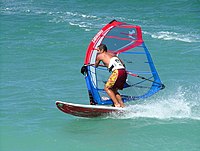
The following is a list of surface water sports. These are sports which are performed atop a body of water.

The following is a list of surface water sports. These are sports which are performed atop a body of water.
Environmental impact includes noise, pollutants, shoreline degradation, and disturbance and dislocation of wildlife, [1] and the governing body, the International Waterski & Wakeboard Federation (IWWF) has been acting to reduce this impact. The IWWF also governs the related sports of barefoot skiing, cable skiing, cable wakeboard, disabled ski, racing, show ski, water skiing, and wakesurfing. [2]

Skurfing is a surface water sport in which the participant is towed on a surfboard, behind a boat, with a ski rope. It is not a professional sport and has no competitions; it is a freestyle sport with a highly individualistic style and form.
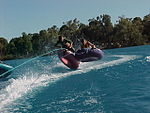
Tubing, also known as biscuiting, is where a large, usually circular, rubber tube is towed behind a boat at fast speeds. The general aim is to hold on as long as possible without falling off due to the boat's sharp turns; more experienced biscuiters also try to jump the boat's wake and become airborne.
Wake sports are sports that involves riding a wake while being towed by a motorboat, personal watercraft, close-course cable systems, ski lifts, winches or a crane, [3] at speeds between 10 mph (wakesurfing) to 25 mph (some professional wakeboarders).
Kneeboarding is an aquatic sport where the participant is towed kneeling on a buoyant, convex, and hydrodynamically shaped board at a planing speed, most often behind a motorboat.
A hydrofoil is towed water ski where the participant is seated on the ski. The ski consists of a seat tower and board, as well as a foil, which rides beneath the water’s surface, with front and rear wings. The participant straps into the hydrofoil ski and secures the safety straps on the seat tower and the foot bindings. After the deep water start, the skier can ski, jump, and attempt aerial tricks launching the hydrofoil off the water and off boat wake. Other variants include a wake surfboard with a foil attached to the back underneath the water. The board can move up and down out of the water based on the position of the rider’s weight. Hydrofoiling is most often done behind a motorboat or jet ski.
In wakeboarding, the participant is towed standing on a small board, riding a wake produced by the towing boat, and attempts to do tricks. Events are organized by the World Wakeboarding Association. [4] A special wakeboard boat has a wakeboard tower, which places the pull point higher above water's surface which makes it easier to jump. Wakeboarding boats have a ballast system that pumps water into tanks to increase displacement, and enlarge the wake.
Wakeskating is an adaptation of wakeboarding that employs a similar design of board manufactured from maple or fibreglass. Unlike wakeboarding, the rider is not bound to the board in any way, similar to the skateboard, from which the name derives. The rider is able to do more complicated tricks than on a wakeboard such as kick flips because of the absence of bindings.
Wakesurfing differs from other wake sports in that the boat does not tow a rider (continuously). The rider uses a tow rope to help them get up in the wake. After doing so, they drop the rope and then ride the wake as they would when surfing. The rider is also much closer to the boat than with other water sports such as wakeboarding.
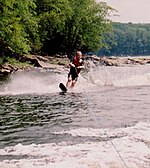
Water skiing is an aquatic sport and recreational activity and is popular in many countries around the world where appropriate conditions exist - an expanse of water unaffected by wave motion. Rivers, lakes, and sheltered bays are all popular for water skiing.
Standard water skis were originally made of wood but now are usually constructed out of fibreglass-based composites. They are of similar length to downhill snow skis but are somewhat wider. Instead of a rigid binding, they have rubber molded binding, in which the skier's feet are placed. Skiers are pulled along by a rope with a handle fitted at one end and attached to a powerboat at the other. There are two types of waterskiing: doubles and slalom. When skiing doubles, you use two skis. When skiing slalom, one ski is used. Slalom skiing is notably harder than doubles.
Boardsports are sports that are played with some sort of board as the primary equipment. The following aquatic boardsports are those that are not towed behind a boat:

A bodyboard is an instrument of wave riding consisting of a small roughly rectangular piece of foam, shaped to a hydrodynamic form. The bodyboard is ridden predominantly lying down, (or 'prone'). It can also be ridden in a half-standing stance (known as 'dropknee') or can even be ridden standing up.
Flowriding, also known as flowboarding, is a late-20th century alternative boardsport incorporating elements of surfing, bodyboarding, skateboarding, skimboarding, snowboarding and wakeboarding. Flowriding takes place on an artificial wave machine, called the FlowRider or the FlowBarrel, created by Wave Loch.

Kiteboarding, also known as kitesurfing, and sometimes as flysurfing, involves using a power kite to pull a small surfboard with bindings.
Jetboarding, also known as motorized surfboarding, is a type of water sport that involves riding a surfboard with electric- or petrol-powered system. Riders can achieve high speed to 70 km/h in a very short of period with a hand controller. [5]
Paddleboarding is an activity in which a person paddles a long streamlined surfboard with their hands. This is done while laying or kneeling on the board. Paddleboards are raced throughout the world.
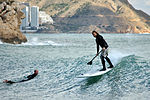
Standup paddleboarding (SUP), also known as standup paddle surfing, is a water sport born from surfing with modern roots in Hawaii. Stand up paddle boarders stand on boards that are floating on the water, and use a paddle to propel themselves through the water.
In riverboarding, also known as hydrospeed or white-water sledging, the participant lies prone on their board with fins on their feet for propulsion and steering.
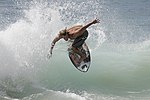
Skimboarding is a boardsport which involves riding a skimboard either on an outgoing wave, or in shallow water, where instead of going for waves the rider may attempt to ride a rail or do "tech" tricks.

Surfing is a recreational activity in which individuals paddle into a wave on a surfboard, jump to their feet, and are propelled across the water by the force of the wave. Surfing's appeal probably derives from an unusual confluence of elements: adrenaline, skill, and high paced maneuvering are set against a naturally unpredictable backdrop—an organic environment that is, by turns, graceful and serene, violent and formidable.
Windsurfing is a sport involving travel over water on a small 2–4.7 metre board powered by wind acting on a single sail. The sail is connected to the board by a flexible joint. The sport is a hybrid between sailing and surfing. The sail board might be considered the most minimalistic version of the modern sailboat, with the major exception that steering is accomplished by the rider tilting the mast and sail or, when planing, carving the board, rather than with a rudder.
Wing foiling or wingsurfing is a sport where an individual holds a lightweight wing on a surf board with a hydrofoil.

Bodysurfing is the art and sport of riding a wave without the assistance of any buoyant device such as a surfboard or bodyboard. Bodysurfers typically equip themselves only with a pair of specialized swimfins that stay on during turbulent conditions and optimize propulsion.
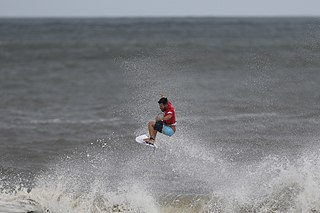
Surfing is a surface water sport in which an individual, a surfer, uses a board to ride on the forward section, or face, of a moving wave of water, which usually carries the surfer towards the shore. Waves suitable for surfing are primarily found on ocean shores, but can also be found as standing waves in the open ocean, in lakes, in rivers in the form of a tidal bore, or wave pools.

Wakeboarding is a water sport in which the rider, standing on a wakeboard, is towed behind a motorboat across its wake and especially up off the crest in order to perform aerial maneuvers. A hallmark of wakeboarding is the attempted performance of midair tricks. Wakeboarding was developed from a combination of water skiing, snowboarding and surfing techniques.
Boardsports are active outdoor sports that are played with any sort of board as the primary equipment. These sports take place on a variety of terrains, from paved flat-ground and snow-covered hills to water and air. Most boardsports are considered action sports or extreme sports, and thus often appeal to youth. Some board sports were marginalized in the past. However, many board sports are gaining mainstream recognition, and with this recognition, they have gotten wider broadcasting, sponsorship and inclusion in institutional sporting events, including the Olympic Games.

Surfboard wax is a formulation of natural and/or synthetic wax for application to the deck of a surfboard, bodyboard, or skimboard, to keep the surfer from slipping off the board when paddling out or riding a wave. It is also used to increase grip on the paddle of a surf kayak or dragon boat.

Skimboarding or skimming is a boardsport in which a skimboard is used to glide across the water's surface to meet an incoming breaking wave, and ride it back to shore. There are currently 3 U.S. based competitive organizations including Premier Skim, Skim USA, and the United Skim Tour. Wave-riding skimboarders perform a variety of surface and air maneuvers, at various stages of their ride, out to, and back with, the wave. Some of these are known as "wraps", "big spins", "360 shove-its" and "180s". Unlike surfing, skimboarding begins on the beach by dropping the board onto the thin wash of previous waves. Skimboarders use their momentum to skim out to breaking waves, which they then catch back into shore in a manner similar to surfing.

Laird John Hamilton is an American big-wave surfer, co-inventor of tow-in surfing, and an occasional fashion and action-sports model and actor. He is married to Gabrielle Reece, a former professional volleyball player, television personality, and model.

A foilboard, also known as a hydrofoil board or foil surfboard, is a type of board used in water sports; it is distinct from surfboards in that it has a hydrofoil rather than fins mounted underneath. This hydrofoil design allows the surfboard and its rider to rise above the water’s surface, allowing for fast speeds and increased maneuverability in a wide range of surf conditions. Foilboards are becoming increasingly popular across many water sports, including surfing, kiteboarding, windsurfing, and wakeboarding. Foilboards have also been used in competitions, with riders reaching speeds of up to 30 km/h while performing acrobatic maneuvers such as flips and twists.
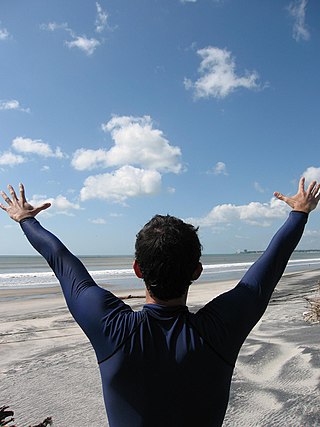
A rash guard, also known as rash vest or rashie, is an athletic shirt made of spandex and nylon or polyester. The name rash guard reflects the fact that the shirt protects the wearer against rashes caused by abrasion, or by sunburn from extended exposure to the sun, as sun protective clothing.

The Waveski, previously known as the "Paddle Ski”, is a surfboard that the rider 'sits' on top of. Waveski surfing is a dynamic sport combining paddle power with the manoeuvrability and performance of a surfboard. A Waveski resembles a larger volume surfboard, with the addition of a hollowed out seat that has a seat belt, feet straps enabling the rider to remain attached to the board for maneuvers and surfed with a double ended paddle which also helps to flip upright if capsized in an action called the 'Eskimo roll' when overturned. The waveski rider or surfer uses a double-ended paddle for paddle propulsion and assist in turns. To turn, the rider uses their weight to lean on the side rail with the and paddle to pivot or propel the board up the wave. The sport is categorized under the International Canoe Federation and holds biennial World championship events.

A kneeboard is a board ridden in a kneeling stance. Kneeboards are ridden in ocean surf, or while being towed behind a boat on a lake or river.
Skurfing is a towed water sport in which an individual is pulled behind a boat on a tow rope. The sport uses a skurfboard, which is a floating platform the user balances on, similar to a surfboard but typically much shorter, with two foot-straps that prevent falling off the board and three fins positioned on the bottom that make it easier to maneuver when the board is being towed. The word itself is a portmanteau of skiing and surfing. Skurfing is often considered the precursor to wakeboarding.

Wakesurfing is a water sport in which a rider trails behind a boat, riding the boat's wake without being directly pulled by the boat. After getting up on the wake, typically by use of a tow rope, the wakesurfers will drop the rope, and ride the steep face below the wave's peak in a fashion reminiscent of surfing. Wakesurfers generally use special boards, designed specifically for wakes.

The sit-down hydrofoil, first developed in the late 1980s, is a variation on water skiing, a popular water sport. When towed at speed, by a powerful boat or some other device, the board of the hydrofoil 'flies' above the water surface and generally avoids contact with it, so the ride is largely unaffected by the wake or chop of the water and is relatively smooth. The air board is a modified hydrofoil where the skier stands up.

Wakeboard boats also known as wakeboats, surfboats or tow boats are designed to create a large, specially shaped wake, for a wakeboarder to jump the wakes from side to side doing aerial tricks. They developed from the Runabout type.
Nautique Boat Company is an American boat manufacturer that produces boats primarily for waterskiing, wakeboarding and wakesurfing. With models in the Super Air Nautique and Ski Nautique lines, they are widely considered the gold standard in the inboard towboat market. Owned by parent company, Correct Craft, Nautique is a member of the oldest family-owned and operated boat manufacturer in the world.
Paddleboarding is a water sport in which participants are propelled by a swimming motion using their arms while lying or kneeling on a paddleboard or surfboard in the ocean or other body of water. Paddleboarding is usually performed in the open ocean, with the participant paddling and surfing unbroken swells to cross between islands or journey from one coastal area to another.

Flowriding is a late 20th century alternative boardsport incorporating elements of surfing, bodyboarding, skateboarding, skimboarding, snowboarding and wakeboarding.
Centurion Boats, owned by Fineline Industries, is a manufacturer specializing in the production of water sports boats, primarily tow boats for wakesurfing and wakeboarding. It was founded by current owner Rick Lee. Its headquarters and manufacturing operations are in Merced, California.
Horse surfing is an extreme sport invented in 2004. It requires two people, a horse, and a board. Horse surfing involves one person riding either kite-board, surfboard, wake-board, or skim-board, while being towed behind a horse, ridden by a second person, through shallow water, at speeds up to 40 miles per hour (64 km/h). After originating in England the first official horse surfing competition was held in 2006 in La Baule, France, and over the last 14 years the sport has continued to spread internationally. Today there are several competitions with globally established rules and categories.